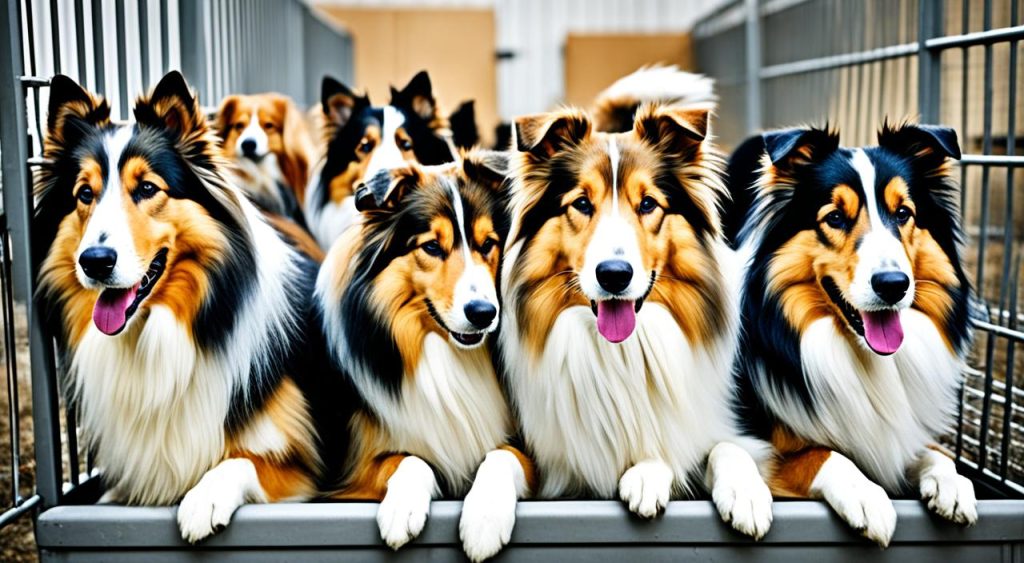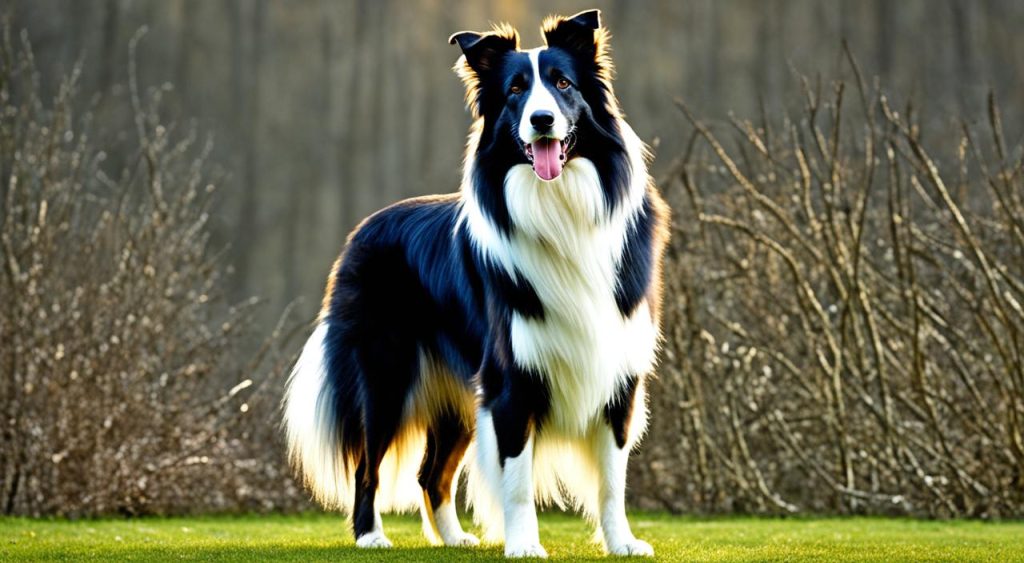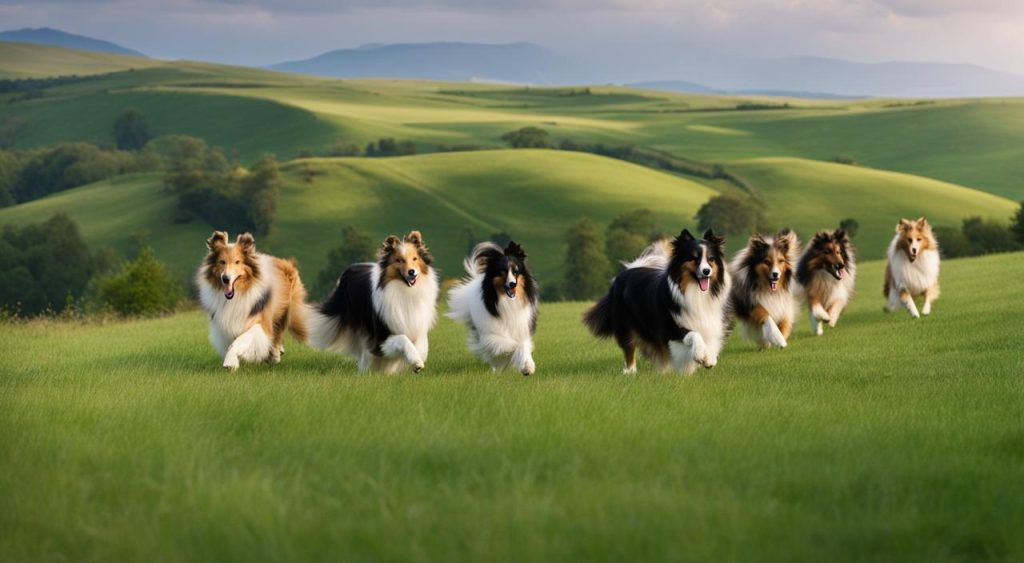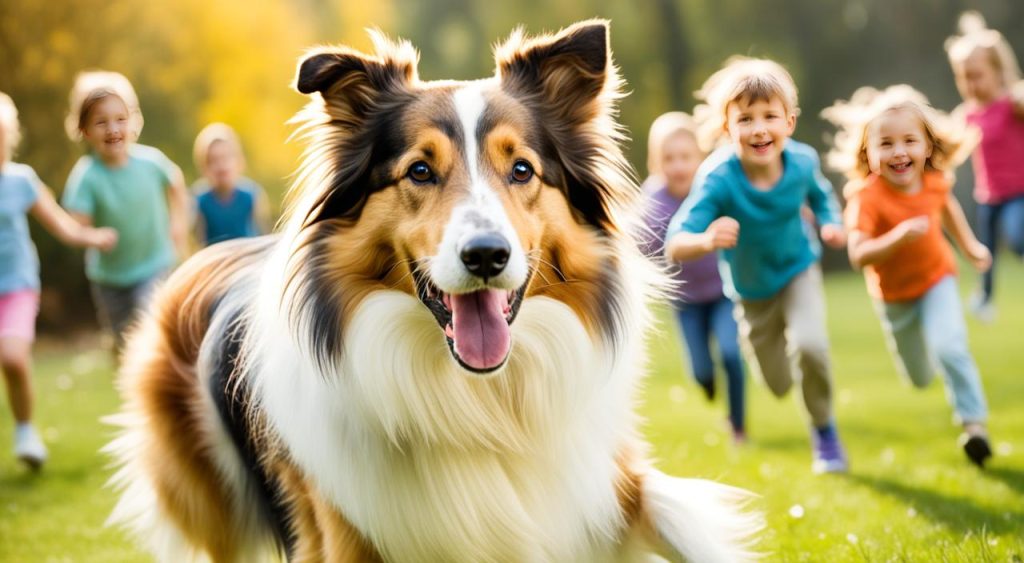The rough collie breed, once beloved for its friendly temperament and striking appearance, is currently experiencing a decline in popularity. Despite being widely recognized for their role as Lassie in popular media, rough collies are facing a lack of interest and a decreasing preference among potential dog owners. This trend raises concerns about the future of the breed and its overall recognition in the dog-loving community.
Key Takeaways:
- The popularity of rough collies has been declining over the years.
- Last year, the number of rough collie puppy registrations hit a record low.
- The breed’s association with the character Lassie contributed to its popularity in the past.
- Factors such as health issues, grooming needs, and evolving breed trends may have impacted rough collie’s decline in popularity.
- Promoting responsible breeding practices and increasing breed awareness can help preserve the rough collie breed.
Historical Significance of Rough Collies
When people think of rough collies, the character Lassie often comes to mind. Lassie’s popularity began in the 1940s with a novel, followed by films, television series, radio programs, animations, and comic books. The rough collie’s association with Lassie contributed to its popularity in the past. However, despite its historical significance, the breed is facing a decline in popularity today.
In the mid-20th century, Lassie emerged as the epitome of a loyal and intelligent dog. The heartwarming stories of Lassie’s bravery and unwavering devotion captured the hearts of millions worldwide. This media presence established the rough collie as a beloved household name and cemented its place in popular culture.
During the height of Lassie’s popularity, rough collies became sought-after pets and companions. Families were drawn to their striking appearance, intelligence, and the belief that they possessed the same qualities as their on-screen counterpart. The rough collie’s remarkable resemblance to the fictional Lassie heightened its appeal and solidified its status as a treasured breed.
However, despite the initial fame and endearing portrayal of Lassie, the rough collie’s popularity has waned in recent years. Changing trends, evolving preferences, and the emergence of other breeds have contributed to this decline. Today, the rough collie struggles to regain the recognition and admiration it once enjoyed.
Current Breed Status
The rough collie breed is currently facing a concerning decline in popularity, which has raised concerns about its future. With record-low numbers in over 75 years, the breed is on the verge of being classified as “at risk” by The Kennel Club, an organization that monitors breeds with declining numbers.
Last year, the rough collie breed saw a significant drop in numbers, with less than 500 rough collie puppies born. This is the lowest recorded number since the 1940s, indicating a 94% decline since its peak in 1979. If the decline continues, rough collies may be included in The Kennel Club’s “at watch” list or even the “vulnerable native breeds” list, highlighting the risk of the breed disappearing.
This image depicts a beautiful rough collie, showcasing the breed’s distinctive features and highlighting the importance of preserving this iconic breed.
Breed Characteristics and Temperament
Rough collies are known for their friendly and happy temperament. They can be great companions, especially for families with children. The rough collie’s gentle nature makes them well-suited to living in a household with kids, and they are often patient and protective with their younger human counterparts.
However, it’s important to note that the rough collie breed may not be a perfect fit for everyone. They are active and intelligent dogs that require physical and mental stimulation to thrive. If you’re considering adding a rough collie to your family, it’s crucial to provide them with the right space and environment to meet their exercise needs and mental stimulation requirements.
Rough collies have a lot of love to give and are known for their loyalty and affectionate nature. They are often eager to please their owners and form strong bonds with their families. Their gentle and calm demeanor makes them a popular choice for therapy and service dog work.
Despite their wonderful temperament and undeniable charm, rough collies have seen a decline in popularity in recent years. This decline may be a missed opportunity for potential owners who could benefit from the companionship and loyalty of this remarkable breed.
Influences on Breed Popularity
The popularity of dog breeds can be influenced by various factors. These influences can shape trends in breed popularity and play a significant role in determining which breeds capture the public’s attention. Understanding these influences can shed light on the rise and decline of certain breeds.
Media Influence:
One key factor that can impact breed popularity is media representation. Movies, TV shows, and other forms of media often feature specific breeds, which can create a surge in interest and popularity. The enduring fame of fictional dogs like Lassie and Rin Tin Tin has contributed to the popularity of rough collies and German shepherds, respectively.
Economic Factors:
Economic considerations also come into play when it comes to breed popularity. The cost of care and maintenance for certain breeds can influence people’s decision to adopt or purchase a specific breed. Breeds that require extensive grooming or have high exercise needs may be more costly to maintain, which can deter potential owners.
Grooming Requirements:
Grooming requirements can also impact a breed’s popularity. Breeds that require frequent and intensive grooming, such as poodles with their elaborate cuts, may see a decline in popularity due to the time, effort, and cost associated with grooming. On the other hand, breeds with low grooming needs, like short-haired breeds, may be more appealing to those seeking low-maintenance pets.
Exercise Needs:
Similarly, a breed’s exercise needs can influence its popularity. Breeds that require substantial amounts of exercise and mental stimulation may be less suitable for individuals with busy lifestyles or limited access to outdoor spaces. This can contribute to a decline in popularity for these active breeds.
Allergies:
Allergies are another factor that can impact breed popularity. Breeds that shed less dander and are considered hypoallergenic may rise in popularity among individuals who have allergies or sensitivities. These breeds are often better suited for households with allergy sufferers, as they tend to produce fewer allergens.
Overbreeding:
Overbreeding can have a detrimental impact on a breed’s popularity. When a breed is overbred without proper consideration for health and temperament, it can lead to an increase in health issues and behavioral problems. This can tarnish the reputation of the breed and result in a decline in popularity as potential owners become aware of these issues.
In conclusion, breed popularity is influenced by a variety of factors, including media representation, economic considerations, grooming requirements, exercise needs, allergies, and overbreeding. Understanding these influences can provide valuable insights into the rise and decline of different breeds over time.
Other breeds experiencing popularity changes
The popularity of dog breeds can fluctuate over time, with some breeds experiencing a decline in popularity while others rise in popularity. For example, breeds like the Yorkshire terrier and cocker spaniel have faced declines in popularity in the past.
On the other hand, breeds like the Labrador retriever, German shepherd, and golden retriever have consistently remained popular among dog owners.
The reasons for these changes in breed popularity can vary and are influenced by several factors:
- Media representation: Dogs that are prominently featured in movies, TV shows, and commercials tend to gain popularity.
- Cost of care: Some breeds may become less popular if they require high maintenance or have expensive health requirements.
- Grooming requirements: Breeds with intricate grooming needs may decline in popularity, as they require more time and effort from their owners.
- Exercise needs: Dogs that require extensive exercise or specific living environments may see fluctuations in popularity based on the lifestyle of potential owners.
- Temperament: Breeds that are known for their friendly and adaptable temperaments tend to maintain or rise in popularity.
Understanding the various factors that contribute to breed popularity allows us to appreciate the ever-changing preferences of dog owners. By staying informed about breed trends, we can better understand why certain breeds may decline or rise in popularity over time.
Collie-specific factors influencing popularity
The rough collie breed, in particular, has faced specific challenges that may have contributed to its declining popularity. Health issues, such as detached retinas, have become prevalent in the breed. Additionally, some potential owners may be drawn to breeds that are more interactive with their human families and have lower grooming requirements.
Collie health issues can be a concern for prospective owners, as certain genetic conditions such as detached retinas can be more common in the breed. It is important to be aware of these potential health issues and take preventive measures to ensure the well-being of your collie companion.
Another factor that may influence the popularity of rough collies is their temperament. While rough collies are known for their friendly and happy nature, some individuals may prefer breeds that are more interactive and responsive to their human family members. Each breed has its own unique temperament traits, and it is important to choose a breed that aligns with your lifestyle and preferences.
In addition to health concerns and temperament, collie grooming needs can also be a consideration for potential owners. Rough collies have long hair that requires regular brushing and grooming to keep it healthy and free from mats. This level of grooming maintenance may not be suitable for individuals with busy lifestyles or limited time for extensive grooming sessions.
The Role of Responsible Breeding
Responsible breeding practices are paramount to maintaining the popularity and well-being of dog breeds. Breeders who prioritize health testing and focus on producing dogs with good temperaments contribute to the overall welfare of the breed and ensure that puppies are matched with suitable owners.
When it comes to responsible dog breeding, health testing is crucial. By conducting thorough health assessments, including genetic tests, breeders can identify potential health issues and make informed decisions about which dogs to breed. This helps to reduce the risk of passing on genetic disorders to future generations.
However, breeding for temperament suitability should not be overlooked. While physical traits may be desirable, it’s important to prioritize temperament when selecting breeding pairs. Dogs with good temperaments are more likely to be well-behaved, adaptable, and compatible with different households.
Responsible breeders understand the importance of matching the right dog with the right owner. Rather than focusing solely on appearance or color preferences, they consider the individual needs, lifestyle, and experience of potential owners. By doing so, responsible breeders help ensure that each dog finds a loving and suitable forever home.
The importance of breed awareness
When it comes to preserving and promoting the popularity of certain dog breeds, increasing breed awareness is crucial. Many potential dog owners may not be aware of the wide range of breeds available and the unique characteristics each one possesses. By promoting breed awareness, we can help individuals make informed decisions when selecting the right breed for their lifestyle and preferences.
Choosing the right breed is essential for ensuring a successful and harmonious relationship between the owner and the dog. Each breed has its own temperament, energy levels, maintenance requirements, and compatibility with different living environments. By educating the public about these factors, we empower individuals to make an educated choice that aligns with their needs.
Having a clear understanding of breed characteristics and requirements can prevent potential issues in the future. By educating yourself about different breeds, you can select a dog that matches your lifestyle, whether you live in an apartment or have a large backyard, have small children or live alone, or prefer a low-maintenance or high-energy companion.
Breed awareness not only benefits potential dog owners but also contributes to the preservation and popularity of certain breeds. By promoting awareness, we can ensure that breeds with unique traits and qualities continue to be valued and recognized. Additionally, educating the public about responsible breeding practices and discouraging overbreeding can help maintain the overall health and well-being of breeds.
In conclusion, promoting breed awareness is essential for preserving and promoting the popularity of dog breeds. By educating individuals about the different breeds available and their unique characteristics, we empower them to make informed decisions when choosing a dog. This not only benefits potential owners but also contributes to the preservation and recognition of various breeds and helps maintain their overall popularity and well-being.
Conclusion
The declining popularity of rough collies is a concerning trend that highlights the importance of breed preservation efforts. Factors such as media representation, economic considerations, grooming requirements, exercise needs, and overbreeding can all contribute to changes in breed popularity.
Responsible breeding practices and increasing breed awareness are crucial for maintaining the popularity and well-being of rough collies and other breeds. By prioritizing health testing and producing dogs with good temperaments, breeders can contribute to the overall welfare and popularity of the breed. Additionally, educating the public about different breeds and their unique characteristics can help potential dog owners make informed decisions when selecting a dog.
It is essential to recognize the unique characteristics and benefits that each breed can offer. Rough collies, with their friendly and happy temperament, can be great companions, especially for families with children. Preserving the breed’s popularity ensures that potential owners can continue to benefit from their loyal and affectionate nature. Breed preservation efforts are essential to maintain the diversity and well-being of dog breeds for future generations.





